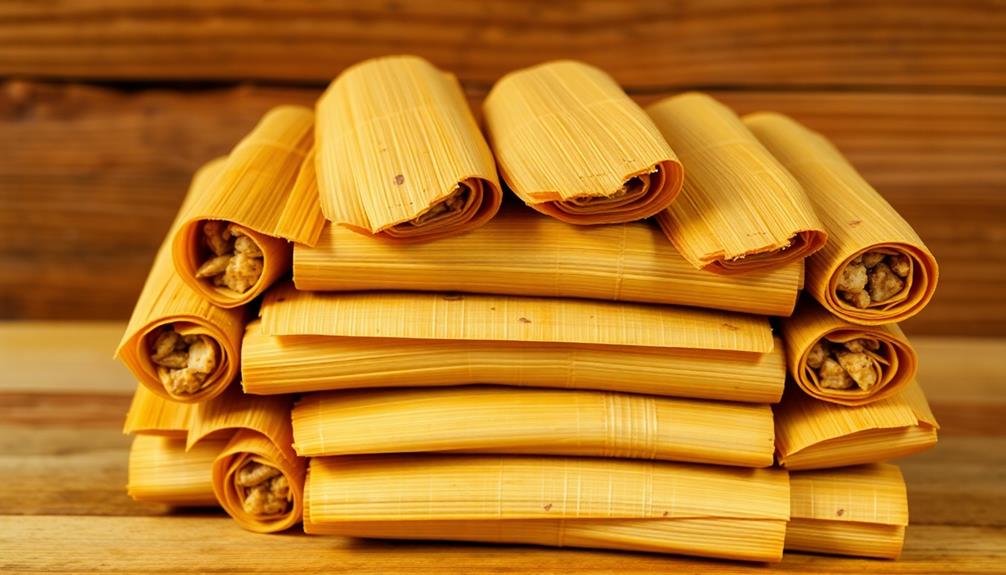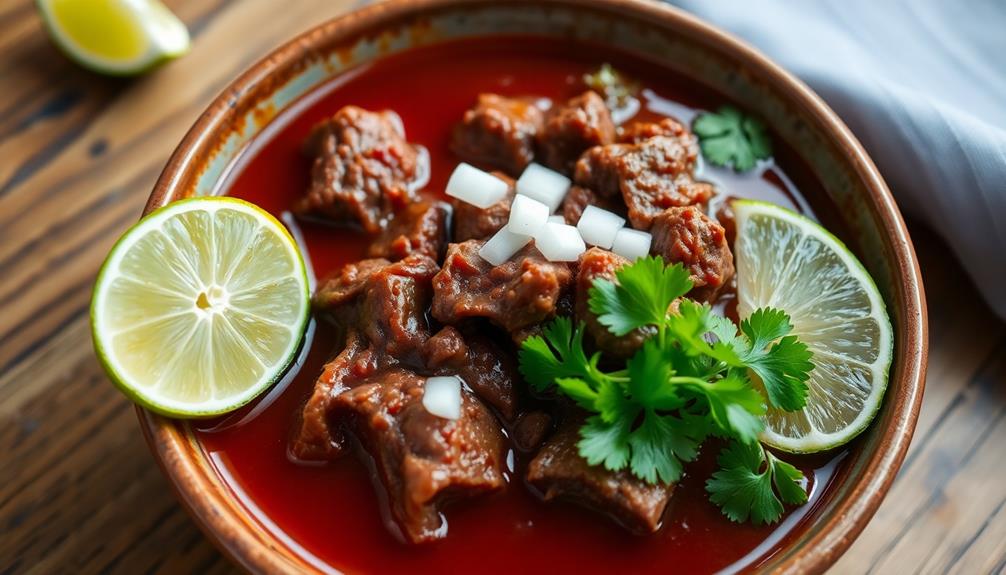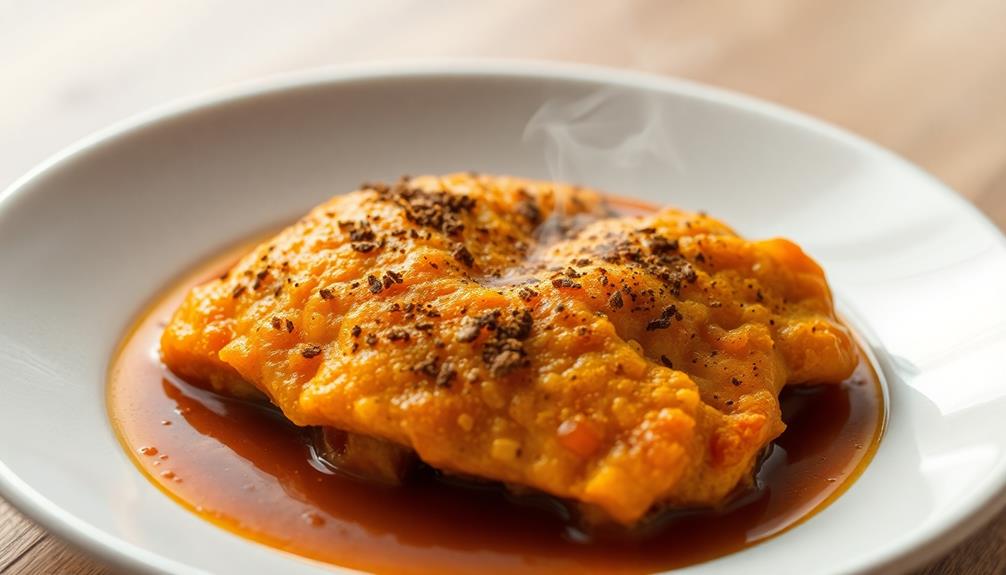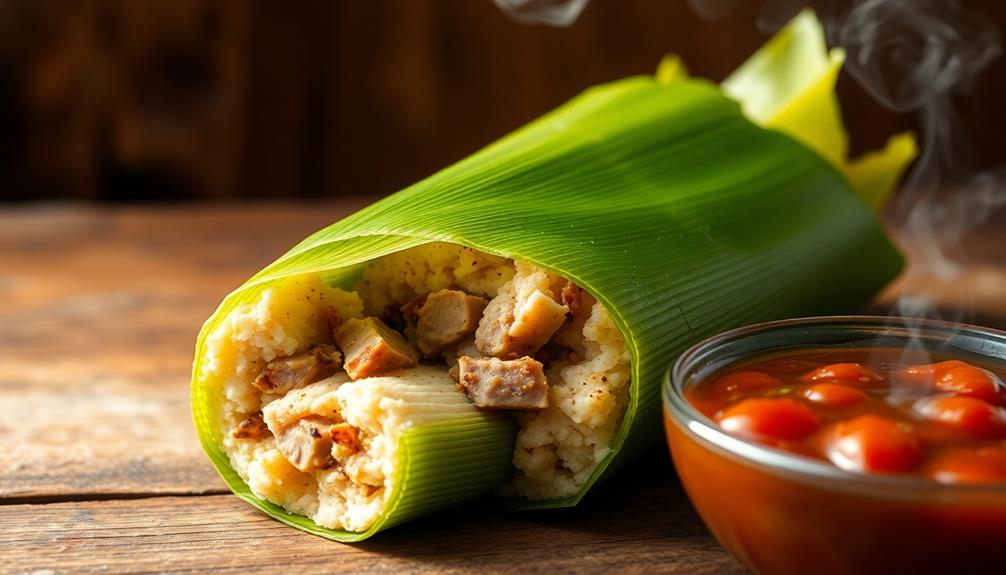Tamales are a cherished part of Latin American culture, with a long history dating back thousands of years! These savory or sweet parcels, wrapped in corn husks or banana leaves, are a true delight. The process of making tamales is a labor of love, but the reward is worth it – the aroma of the steaming corn husks, the soft and fluffy masa, and the flavorful fillings all come together for an unforgettable culinary experience. Whether you're enjoying them with family or sharing them with friends, tamales are sure to bring joy and a taste of tradition. If you're curious to learn more, just keep reading!
Key Takeaways
- Tamales have a rich history tracing back to ancient Mesoamerican civilizations, where they served as a staple food and held symbolic importance.
- The traditional tamale consists of masa (corn dough) and various fillings, with the cooking method involving steaming wrapped tamales in corn husks or banana leaves.
- The process of making tamales can be labor-intensive but rewarding, fostering patience, attention to detail, and the opportunity to share culinary knowledge.
- Tamales are often associated with special occasions and celebrations, representing communal cooking, shared experiences, and family heritage.
- Learning to make tamales enhances cooking abilities, encourages the exploration of diverse cuisines, and boosts confidence in kitchen skills and creativity.
History
The origins of tamales can be traced back to the ancient Mesoamerican civilizations, where they served as a staple food for both the commoners and the elite.
These delicious parcels of masa (corn dough) filled with savory or sweet ingredients were an integral part of the local cuisine, with records showing their existence as early as 8000 BC.
Over time, the recipe and preparation methods evolved, with different regions developing their own unique variations. Some tamales were wrapped in banana leaves, while others were cooked in corn husks, creating a wide array of flavors and textures.
From the Aztecs to the Maya, tamales held a special place in the hearts and stomachs of these ancient cultures, becoming a beloved symbol of their rich culinary heritage.
Even today, the making and sharing of tamales remains a cherished tradition, bringing families and communities together in the spirit of delicious celebration.
Recipe
Tamales are a traditional Mexican dish that consists of a savory or sweet filling wrapped in a masa (dough) and steamed in a corn husk or banana leaf. They're a beloved part of Mexican cuisine and often associated with special occasions and celebrations.
Tamales can be filled with a variety of ingredients, from shredded meat and vegetables to sweet fillings like fruit or chocolate. The process of making tamales may seem daunting, but with the right recipe and a little patience, anyone can create delicious homemade tamales.
- 2 cups masa harina (corn flour for tamales)
- 1 1/2 cups warm chicken or beef broth
- 1/2 cup lard or vegetable shortening
- 1 teaspoon baking powder
- 1 teaspoon salt
- 2 cups shredded cooked chicken, beef, or pork (or desired filling)
- Corn husks or banana leaves, soaked in water for at least 30 minutes
In a large bowl, combine the masa harina, warm broth, lard, baking powder, and salt. Using a hand mixer or stand mixer, beat the mixture until it becomes light and fluffy, about 5 minutes.
Spread about 2-3 tablespoons of the masa mixture onto the center of a corn husk or banana leaf. Top with 2-3 tablespoons of the desired filling. Fold the sides of the husk or leaf over the filling, then fold up the narrow ends to completely enclose the tamale.
Steam the tamales for 50-60 minutes, or until the masa pulls away easily from the husk.
When cooking tamales, it's important to have a steamer basket or pot large enough to fit all the tamales without overcrowding. Additionally, be sure to soak the corn husks or banana leaves thoroughly to prevent them from tearing during the steaming process.
Serve the tamales warm, with your favorite toppings or sauces.
Cooking Steps
First, you'll need to soak the corn husks in water to soften them.
Then, you'll mix the masa with your favorite fillings.
Next, you'll spread the masa onto the soaked corn husks, fold the tamales tightly, and steam them until they're cooked to perfection.
Step 1. Soak Corn Husks in Water

Soak the corn husks in water for at least an hour. This softens them up, making them perfect for wrapping your tasty tamale filling.
You'll need to fully submerge the husks, so find a large bowl or pot to hold them all. As they soak, they'll become pliable and easy to work with.
While the husks are soaking, you can prepare the rest of your tamale ingredients. Once the husks are ready, take them out one by one, gently shaking off any excess water.
Lay them out flat on a clean surface, ready to be filled. The soaked husks will have a lovely green color and a soft, supple texture.
Get ready to assemble your tamales! With the husks prepped, you're one step closer to enjoying these delicious homemade treats.
Step 2. Mix Masa With Fillings
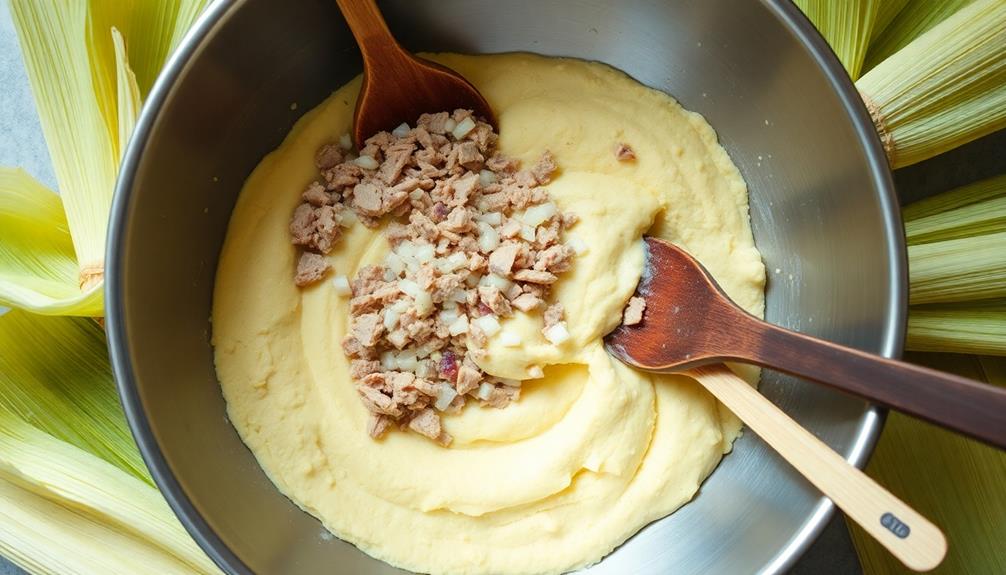
With the corn husks ready, you can now start mixing the masa with your desired fillings. It's time to get creative!
First, in a large bowl, combine the prepared masa with your choice of tasty ingredients. Maybe you'll go for a classic filling of shredded chicken, or perhaps you're in the mood for something more adventurous, like savory black beans or spicy pork.
Gently fold everything together until the masa and fillings are evenly distributed. Don't be afraid to get your hands a little messy – the mixing process is half the fun! You'll want the mixture to have a smooth, spreadable consistency, so add a bit of broth or water if it seems too thick.
Once you're satisfied with the texture, it's time to start assembling your tamales. Scoop a generous portion of the masa mixture onto the center of each corn husk, then fold and wrap them up tightly.
Soon, your kitchen will be filled with the mouthwatering aromas of homemade tamales, ready to be steamed to perfection.
Step 3. Spread Masa Onto Soaked Corn Husks
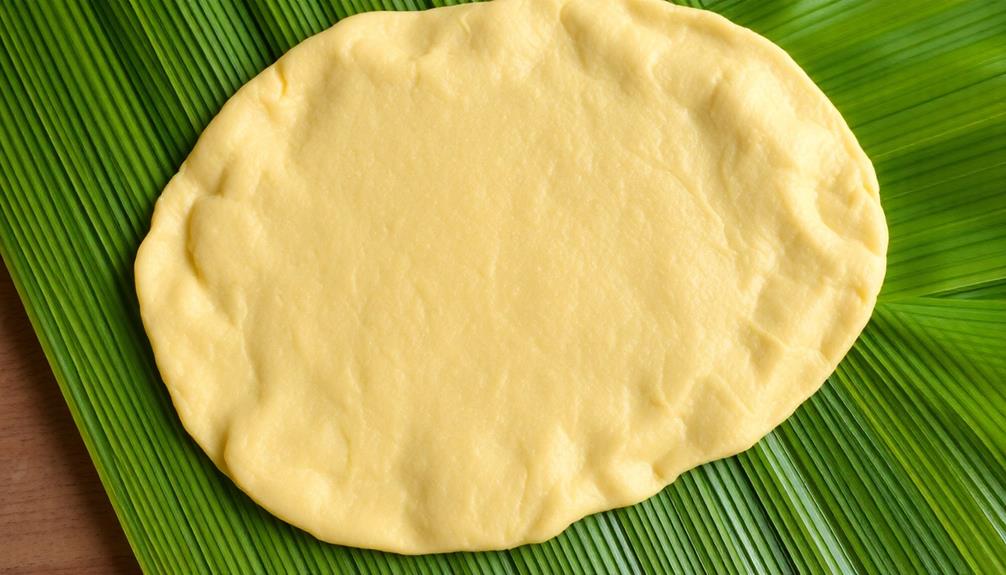
To assemble the tamales, scoop a generous amount of the prepared masa mixture onto the center of a soaked corn husk.
Using the back of a spoon, spread the masa in an even layer, leaving about an inch of the husk uncovered on each side. This will allow you to easily wrap and fold the tamale.
Next, add your favorite filling in a line down the center of the masa. Be sure not to overstuff, as you'll want to be able to tightly wrap the tamale.
Fold the long sides of the husk over the filling, then fold the narrow ends toward the center, creating a neat little package. Secure the tamale by tying it with kitchen string or strips of the corn husk.
Place the wrapped tamales in a steamer basket, making sure they don't touch each other.
Steam the tamales for 40-50 minutes, until the masa pulls away from the husk easily. Unwrap and enjoy your homemade tamales!
Step 4. Fold Tamale Tightly Into Husk
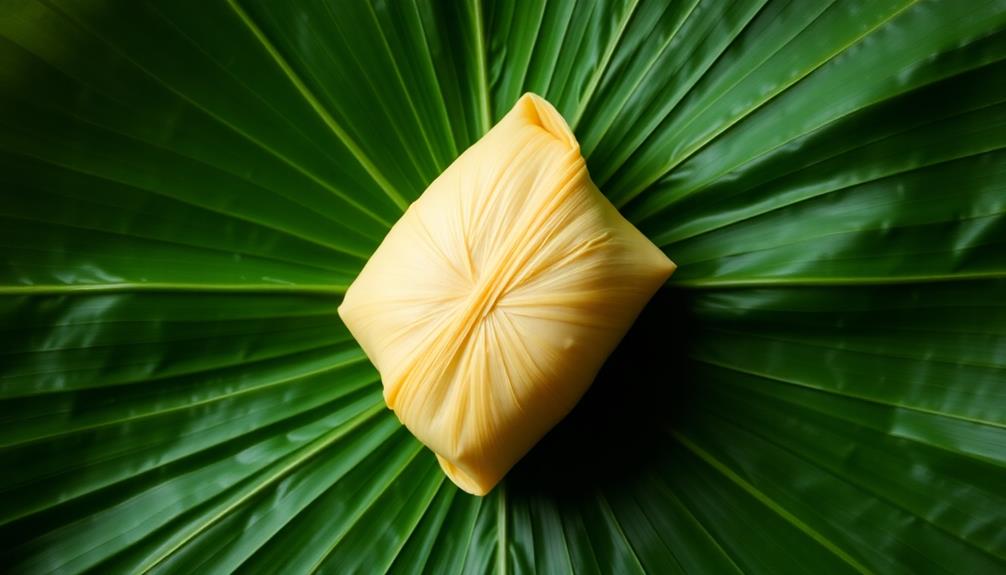
After adding the filling, carefully fold the long sides of the husk over the masa, then fold the narrow ends toward the center to create a compact package.
Gently press down to secure the tamale. Make sure it's nice and tight – you don't want any of that delicious filling to spill out!
Now, use the extra husk to tie the tamale closed. Wrap the string around the center, then the two ends. Tie it in a knot to hold everything together. This will help the tamale keep its shape as it cooks.
Once your tamale is all wrapped up, place it in the steamer basket, making sure not to overcrowd.
Cover and let it steam for around an hour, until the masa pulls away from the husk easily. Mmm, can you smell that heavenly aroma? Your homemade tamales are almost ready to enjoy!
Step 5. Steam Tamales Until Cooked

Once your tamales are all wrapped up, it's time to steam them until they're perfectly cooked. Grab a large pot and fill it about a quarter of the way with water. Carefully place the wrapped tamales in the pot, making sure they're not touching each other. Cover the pot with a tight-fitting lid and turn the heat to medium-high.
As the water starts to simmer, the steam will begin to cook the tamales from the outside in. Let them steam for about an hour, adding more water if needed to keep the pot from drying out. You'll know they're done when the masa (the corn dough) easily pulls away from the husk. Mmm, can you already smell those delicious, steamy tamales?
Once they're cooked through, use tongs to carefully remove the tamales from the pot. Unwrap them and enjoy their warm, fluffy goodness.
Whether you top them with salsa, cheese, or just eat them plain, these homemade tamales are sure to be a hit!
Final Thoughts
As you consider your newfound appreciation for the art of tamale-making, remember that the journey is just as important as the final product. The time and care you've put into preparing these delightful packages of flavor are what make them truly special.
Whether your tamales turned out perfectly or needed a bit more practice, you should feel proud of yourself for trying something new and expanding your culinary skills.
Tamales are a beloved tradition passed down through generations, and by learning to make them, you're now part of that rich history. Imagine the smiles on your family's faces as they unwrap your homemade tamales, savoring each bite.
The aroma of the steaming corn husks, the tender texture of the masa, and the burst of flavor from the fillings – these are the moments that make the effort worthwhile.
Frequently Asked Questions
What Is the Nutritional Value of Tamales?
You'll find that tamales provide a good source of carbohydrates, protein, and some essential vitamins and minerals. However, their nutritional value can vary depending on the specific ingredients used in their preparation.
How Long Do Homemade Tamales Last?
Homemade tamales typically last 3-4 days when stored properly in the refrigerator. They can also be frozen for up to 6 months, which'll help preserve their freshness and flavor. Just be sure to thaw them before reheating.
Can I Freeze Tamales for Later Use?
Yes, you can definitely freeze tamales for later use. Freezing helps preserve the freshness and flavor of homemade tamales. Just be sure to wrap them tightly and store them properly to prevent freezer burn.
What Are the Most Common Tamale Fillings?
The most common tamale fillings are pork, chicken, cheese, and vegetables. You can choose from a variety of fillings to suit your taste preferences, making tamales a versatile and customizable dish.
Is It Possible to Make Tamales in a Slow Cooker?
Yes, you can make tamales in a slow cooker. The slow cooking process allows the masa to steam and the fillings to heat through, resulting in moist and flavorful tamales. It's a convenient way to enjoy this traditional dish.
